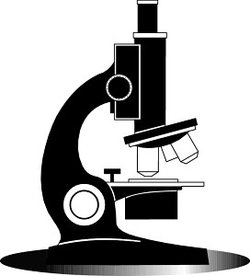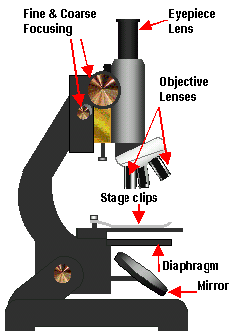Microscope
|
|
The most common type of microscope—and the first to be invented—is the optical microscope. This is an optical instrument containing one or more lenses that produce an enlarged image of an object placed in the focal plane of the lens(es).
See also: Microscopy.
| Contents |
Simple optical microscope
A simple microscope, as opposed to a standard compound microscope (see below) with multiple lenses, is a microscope that uses only one lens for magnification. Van Leeuwenhoek's microscopes consisted of a single, small, convex lens mounted on a plate with a mechanism to hold the material to be examined (the sample or specimen). This use of a single, convex lens to magnify objects for viewing is still found in the magnifying glass, the hand-lens, and the loupe.
Compound optical microscope
The diagrams below show compound microscopes. In its simplest form—as used by Robert Hooke, for example—the compound microscope would have a single glass lens of short focal length for the objective, and another single glass lens for the eyepiece or ocular. Modern microscopes of this kind are usually more complex, with multiple lens components in both objective and eyepiece assemblies. These multi-component lenses are designed to reduce aberrations, particularly chromatic aberration and spherical aberration. In modern microscopes the mirror is replaced by a lamp unit providing stable, controllable illumination.
|
Compound optical microscopes can magnify an image up to 1000× and are used to study thin specimens as they have a very limited depth of field. Typically they are used to examine a smear, a squash preparation, or a thinly sectioned slice of some material. With a few exceptions, they utilize light passing through the sample from below and special techniques are usually necessary to increase the contrast in the image to useful levels (see contrast methods). Typically, on a standard compound optical microscope, there are three objective lenses: a scanning lens (4×), low power lens (10×), and high power lens (40×). Advanced microscopes often have a fourth objective lens, called an oil immersion lens. To use this lens, a drop of oil is placed on top of the cover slip, and the lens moved into place where it is immersed in the oil. An oil immersion lens usually has a power of 100×. The actual power of magnification is the product of the powers of the ocular (usually 10×) and the objective lenses being used.
To study the thin structure of metals (see metallography) and minerals, another type of microscope is used, where the light is reflected from the examined surface. The light is fed through the same objective using a semi-transparent mirror.
Stereo microscope
The stereo, binocular or dissecting microscope is designed differently from the diagrams above, and serves a different purpose. It uses two eyepieces (or sometimes two complete microscopes) to provide slightly different viewing angles to the left and right eyes. In this way it produces a three-dimensional (3-D) visualisation of the sample being examined.
The stereo microscope is often used to study the surfaces of solid specimens or to carry out close work such as sorting, dissection, microsurgery, watch-making, small circuit board manufacture or inspection, and the like. Great working distance and depth of field here are important qualities for this type of microscope. Both qualities are inversely correlated with resolution: the higher the resolution (i.e., magnification), the smaller the depth of field and working distance. A stereo microscope has a useful magnification up to 100×. The resolution is maximally in the order of an average 10× objective in a compound microscope, and often much lower.
Special designs
Other types of optical microscope include:
- the inverted microscope for studying samples from below; useful for cell cultures in liquid;
- the student microscope designed for low cost, durability, and ease of use; and
- the research microscope which is an expensive tool with many enhancements.
History of the microscope
It is impossible to say who invented the compound microscope. Dutch spectacle-makers, Hans Janssen and his son Zacharias Janssen, are often said to have invented the first compound microscope in 1590, but this was a declaration by Zacharias Janssen himself halfway the 17th century. The date is certainly not likely, as it has been shown that Zacharias Janssen actually was just about born in 1590. Another favorite for the title of 'inventor of the microscope' was Galileo Galilei. He developed an occhiolino or compound microscope with a convex and a concave lens in 1609. Christiaan Huygens, another Dutchman, developed a simple 2-lens ocular system in the late 1600's that was achromatically corrected and therefore a huge step forward in microscope development. The Huygens ocular is still being produced to this day, but suffers from a small field size, and the eye relief is uncomfortably close compared to modern widefield oculars.
Anton van Leeuwenhoek (1632-1723) is generally credited with bringing the microscope to the attention of biologists, even though simple magnifying lenses were already being produced in the 1500's, and the magnifying principle of water-filled glass bowls had been described by the Romans (Seneca). Van Leeuwenhoek's home-made microscopes were actually very small simple instruments with a single very strong lens. They were awkard in use but enabled van Leeuwenhoek to see highly detailed images, mainly because a single lens does not suffer the lens faults that are doubled or even multiplied when using several lenses in combination as in a compound microscope. It actually took about 150 years of optical development before the compound microscope was able to provide the same quality image as van Leeuwenhoek's simple microscopes. So although he was certainly a great microscopist, van Leeuwenhoek is, contrary to widespread claims, certainly not the inventor of the microscope.
Science Clipart and Icons
- Free Clipart (http://classroomclipart.com/cgi-bin/kids/imageFolio.cgi?direct=Clipart)
- Chemistry Clipart (http://classroomclipart.com/cgi-bin/kids/imageFolio.cgi?direct=Clipart/Chemistry)
- Chemistry Icons (http://classroomclipart.com/cgi-bin/kids/imageFolio.cgi?direct=Science/Chemistry)
- Science Clipart (http://classroomclipart.com/cgi-bin/kids/imageFolio.cgi?direct=Clipart/Science)
- Science Icons (http://classroomclipart.com/cgi-bin/kids/imageFolio.cgi?direct=Science/Icons)
- Cell Clipart (http://classroomclipart.com/cgi-bin/kids/imageFolio.cgi?direct=Science/Cells)
- Biology Clipart and Pictures (http://classroomclipart.com/cgi-bin/kids/imageFolio.cgi?direct=Science/Biology)
Other types of microscopes
See also microscopy
- Atom probe
- Atomic force microscope
- Darkfield microscope
- Electron microscope
- Field ion microscope
- Field emission microscope
- Phase contrast microscope, see Frits Zernike
- Scanning tunneling microscope
- Virtual microscope
- X-ray microscope
- Total internal reflection fluorescence microscope
- Confocal laser scanning microscopy
See also
- Angular resolution
- How to prepare an onion cell slide
- Microscope image processing
- Microscope slide
- Telescope
External links
- Micscape (http://www.microscopy-uk.org.uk/mag/indexmag.html) - a monthly magazine directed towards the amateur microscopist
- Microscopy (http://www.biologie.uni-hamburg.de/b-online/e03/03.htm)
- Microscope Directory (http://www.microscopes-online.info)
- Royal Microscopical Society (http://www.rms.org.uk/)
- The Microscope (http://www.mcri.org/McRI_products.html) - quarterly journal
- virtual microscope on plankton (http://www.ecoscope.com/cybermic/index.htm)
- A virtual polarization microscope (http://gerdbreitenbach.de/crystal/crystal.html) (requires Java)
- Optical microscopy primer (http://micro.magnet.fsu.edu/primer/index.html)



